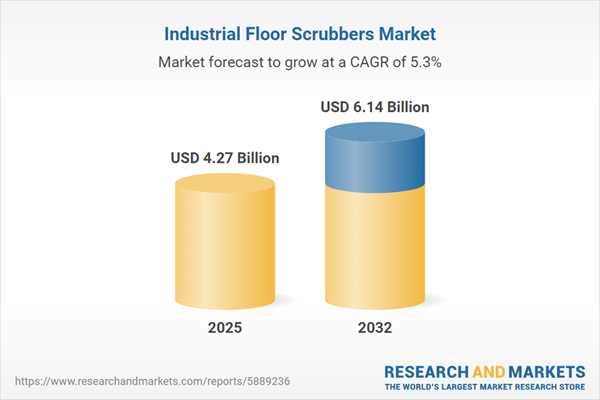Speak directly to the analyst to clarify any post sales queries you may have.
Industrial floor scrubbers are rapidly becoming a cornerstone of effective facility maintenance, enabling organizations to address productivity, hygiene, and sustainability requirements across a diverse set of industries. This report provides senior leaders with actionable insights and deep analysis into the evolving global industrial floor scrubbers market.
Market Snapshot: Industrial Floor Scrubbers Market Growth Drivers
The industrial floor scrubbers market grew from USD 4.06 billion in 2024 to USD 4.27 billion in 2025. The industry is projected to continue rising at a CAGR of 5.29%, reaching USD 6.14 billion by 2032. Growth is being shaped by end-user mandates for efficiency, cleaner environments, and digital integration. The increased adoption of battery-powered and automated solutions reflects a shift towards technologies that improve operational outcomes while reducing resource consumption. This forward momentum is further reinforced by sector-wide investment in sustainability and compliance across manufacturing, healthcare, food & beverage, and large-scale retail operations.
Scope & Segmentation: Comprehensive Market Coverage
- Power Source: Battery (AGM, gel, lithium-ion), diesel, electric, LPG models.
- Product Type: Ride-on (seated, stand-on), walk-behind (automatic drive, manual push).
- Application Sectors: Food & beverage, healthcare, hospitality, manufacturing, retail.
- Distribution Channels: Dealer (tier 1, tier 2), direct (corporate sales, e-tender), online.
- Cleaning Path Width: Under 30 inches, 30–40 inches, above 40 inches for tailored maneuverability and coverage.
- Regional Focus: Americas (North America and Latin America), Europe, Middle East & Africa, Asia-Pacific.
- Technology Drivers: Digital monitoring, cloud-based analytics, predictive maintenance, IoT integration, battery innovation (including lithium-ion), water reclamation, chemical dosing, autonomous navigation.
- Key Companies: Tennant Company, Nilfisk A/S, Alfred Kärcher SE & Co. KG, Hako GmbH, Comac S.p.A., Fimap S.p.A., Ecolab Inc., IPC Eagle, Inc., Minuteman International, Inc., Cleanfix Maschinenbau AG.
Key Takeaways for Senior Decision-Makers
- Operators are prioritizing advanced scrubbers equipped with automation and IoT connectivity to strengthen cleaning outcomes and asset management.
- Battery innovation and environmentally-focused design are critical in aligning with emission reduction and sustainability objectives.
- Autonomous machines and real-time analytics drive consistent performance and minimize unplanned downtime while supporting compliance in regulated sectors.
- Regional adoption patterns vary; North America and Western Europe favor automated, battery-powered solutions, while Asia-Pacific is witnessing a surge in demand for both affordable and high-capacity models.
- Collaboration between equipment manufacturers, component suppliers, and technology partners is accelerating vertical integration and supply chain resilience.
- Distribution strategies that balance direct, dealer, and online channels are instrumental in securing market presence and delivering localized customer support.
Tariff Impact on Supply Chain Resilience and Cost Structures
Recent tariff measures in the United States have impacted global supply chains by increasing component and material costs. Manufacturers responded by exploring alternative sourcing, deepening supplier partnerships, and investing in localized production. These strategies enhanced supply chain agility and mitigated margin pressures, especially for companies with more integrated operations. The industry’s ability to adapt has been a key differentiator in maintaining customer relationships during periods of trade uncertainty.
Industrial Floor Scrubbers Market: Methodology & Data Sources
This report uses a rigorously-structured methodology, including primary interviews with stakeholders such as facility managers, manufacturers, and channel partners, and secondary data from industry publications and trade associations. Insight validation was strengthened through a panel of independent experts and data triangulation, ensuring accuracy and relevance to strategic decision-making.
Why This Report Matters
- Enables data-driven decision making on capital allocation, technology adoption, and risk mitigation across complex facilities and regions.
- Equips executives with actionable strategies for optimizing supply chains, navigating evolving regulatory landscapes, and selecting future-ready cleaning technology portfolios.
Conclusion
Industrial floor scrubbers are reshaping facility maintenance and operational strategy worldwide. Insightful segmentation, regional analysis, and an understanding of tariff implications empower industry leaders to drive innovation, adapt to dynamic shifts, and sustain growth within the global cleaning ecosystem.
Additional Product Information:
- Purchase of this report includes 1 year online access with quarterly updates.
- This report can be updated on request. Please contact our Customer Experience team using the Ask a Question widget on our website.
Table of Contents
3. Executive Summary
4. Market Overview
7. Cumulative Impact of Artificial Intelligence 2025
Companies Mentioned
The companies profiled in this Industrial Floor Scrubbers market report include:- Tennant Company
- Nilfisk A/S
- Alfred Kärcher SE & Co. KG
- Hako GmbH
- Comac S.p.A.
- Fimap S.p.A.
- Ecolab Inc.
- IPC Eagle, Inc.
- Minuteman International, Inc.
- Cleanfix Maschinenbau AG
Table Information
| Report Attribute | Details |
|---|---|
| No. of Pages | 188 |
| Published | October 2025 |
| Forecast Period | 2025 - 2032 |
| Estimated Market Value ( USD | $ 4.27 Billion |
| Forecasted Market Value ( USD | $ 6.14 Billion |
| Compound Annual Growth Rate | 5.2% |
| Regions Covered | Global |
| No. of Companies Mentioned | 11 |









